What is skinned?
This unusual term refers to wall panels made of glass or polymers that perform both protective and decorative functions. The panels can be monolithic or prefabricated, while they are mounted so that the joints remain practically invisible and dirt does not clog in them.
Photo loft style kitchens with an original glass apron containing fun cooking instructions in Russian
Skinali is a powerful design tool to highlight the overall style concept, set a bright accent, add the final touch and transform the kitchen. A rich assortment of textures, colors and prints will help you find the perfect solution for your interior. A wide range of prices also plays into the hands of the customer - you can choose a model for the budget.
The skins' performance is no less impressive: Tempered glass panels last for many years, do not break, do not scratch, easy to clean, not afraid of fire or moisture. Polymer analogs are less strong and durable, but fully justify their low cost.
Typical parameters skipped the following:
- the dimensions of a solid sheet are 1.5 x 3 m, but a panel of the required size will be cut out of it;
- the maximum recommended length of one segment is 2.5 m, otherwise it will be difficult to transport and mount the skin;
- glass thickness - 4-8 mm, while if the sheet is longer than 1.5 meters, its thickness should be from 6 mm.
The final cost of the skin depends on the material chosen, the complexity of the design, the type of painting and the presence of backlighting. Read more about all these nuances below.
Photo small corner kitchen in black and white with bright yellow furniture facades and the same accents on the print
Pros and cons
Skinals for the kitchen have appeared in the arsenal of domestic designers relatively recently, and ordinary people have often never heard of this method of decorating the working area. But caution can be dismissed, because the advantages of this technology more than compensate for the disadvantages.
| pros | Minuses |
|---|---|
| Heat resistance and moisture resistance - tempered glass products can be installed directly above the sink and stove | The need to prepare the wall - it should be perfectly smooth and even so that the glass apron fits snugly against it, because its stability depends on it |
| Environmental friendliness and safety - the material is absolutely safe for health, does not absorb anything and does not serve as a shelter for microbes | Relatively high cost - high-quality products are more expensive than tiles, especially if they are decorated according to an individual sketch and are equipped with lighting |
| Strength and durability - the best models cannot be broken even on purpose, they are resistant to any damage and last up to 80 years | Inability to add technological holes - all measurements must be final, it will not be possible to remove an additional outlet |
| Beauty and wide selection- skinale's design is incredibly diverse, if you wish, you can even give it individuality with the help of your own drawings or photos | Style constraints - not every interior will fit a tempered glass apron, for example, in a Provence, country or shabby chic kitchen, it will look alien |
| Undemanding care - it is enough to wipe the panels with a damp cloth with a non-aggressive detergent, dust and grease hardly adhere to them | |
| Ease of assembly and disassembly - it takes a few minutes, does without consequences in the form of mountains of construction debris and does not cause difficulties even for a non-professional, so you can install or change skins yourself |
What are they made of?
Ordinary glassused in the production of interior doors and windows is the least successful option. The heat from the stove can lead to cracking, so it is permissible to mount simple glass skins no closer than 30 cm from the hob.
Photo of a high-tech kitchen with snow-white and bright red glossy furniture, black countertops and a glass apron, on which cherry repeats the shade of the pedestals
Tempered glass or Stalinite - the most popular material for making kitchen skins. It is heated to 650 degrees Celsius, and then immediately cooled, due to which it acquires phenomenal strength and fire resistance.
Stalinite is of three types:
- satin - has a noble matte surface, but it is more difficult to care for it than for a glossy one, and stains and stains are more clearly visible;
- stemalitis - it is hardened after dyeing, the pigment is baked into the structure of the glass, and the drawing becomes literally eternal;
- optimize - bleaches to neutralize the characteristic bottle green undertones, therefore ideal for transparent skins.
Triplex - the most expensive, but also the most durable type of tempered glass for kitchen aprons... The panel consists of two sheets, between which a film is soldered. Windshields are manufactured using the same technology. That is, even if someone manages to split the triplex skins, they will simply go like a "web" and not scatter into fragments.
Photo of a kitchen with laconic white furniture, wooden countertops and a decorative pale blue wall panel made of the same glass as skinned
The film inside such an apron can be any - even one-color, even mirrored, even with an ornament or a photo. This allows fantasies to run wild and guarantees durability, because the drawing enclosed inside the glass "cake" cannot be spoiled.
Triplex has solid advantages, there are only two disadvantages: high cost and impressive weight (the thickness of the canvas is 8 mm), hence the difficulties with installation. Better to call professionals for help.
Plexiglass acts as a budget replacement for stalinite and can withstand heating only up to 80 degrees, therefore it is not mounted above the gas stove. But it is very easy to refresh and decorate the kitchen wall above the technological line with it, even careful alignment is not required, because the plexiglass bends. Making a hole for an additional socket - no problem.
True, there are also many disadvantages: it fades, turns yellow, scratches and becomes cloudy from aggressive household chemicals.
Polycarbonate looks similar to plexiglass, but suits the kitchen much better. Skinal from it are durable and heat-resistant, but also light and flexible, so any owner can handle their installation. But the disadvantages inherent in polymers have not gone away - the apron quickly loses its gloss under the influence of sunlight and becomes covered with scratches.
Types of image application
The secret of the growing popularity of skinals lies in the variety, and it is provided by different coloring methods.
Photo of a kitchen in a futuristic style, where the color of the starry sky, chosen for the pedestals, is successfully played up in a panoramic view of the night city on a glass apron
Stencil used in the serial production of skin, the ornament is printed on the conveyor.
Lakobel - this is when bright varnish paints are sprayed onto the back of the glass. The finished product can be either plain or with a gradient or abstract print.
Lacomat means a matte varnish, slightly blurring the contours of the picture and removing shine, due to which dirt is less noticeable on the glass.
Photo printing allows you to create skins with any storyline, from juicy fruits and cute animals to family portraits and breathtaking landscapes with a 3D effect.
Film - the most budgetary option, it is glued to the seamy side of the glass, it can have any image or decorative effect (under the skin, fabric, brickwork), but fades over time.
Silkscreen is the application of an ornament using ink baked into the glass, which guarantees richness and durability.
Sandblast Printing - This is the removal of the thinnest layer of glass using an abrasive, resulting in a durable volumetric image.
Laser engraving allows you to evaporate microscopic glass particles from the inner surface of the skin and thereby create complex, detailed patterns.
Hand-painted art - an exclusive reception, therefore the most expensive and appropriate not in every kitchen.
Design ideas
The variety of options is always fraught with a catch: it is difficult to make a choice, especially looking at interesting kitchen skins in the photo in interiors designed by professionals. However, it is not at all necessary to have a design diploma in order to find a stylish glass apron.
there is a few general rules:
- in minimalistic monochrome interiors, skinals can become the main color accent, so it is better to give preference to a juicy photo or colorful ornament;
- the design of the kitchen apron should correspond to the general concept, that is, a snapshot of space is unlikely to be appropriate among rattan and mats, and a bamboo forest will not take root in the high-tech stone jungle;
- a delicately and pastorally decorated kitchen implies the installation of light monochromatic skins or those with a discreet pattern, and dynamic and contrasting plots are relevant for modern interiors in dark and bright colors;
- it is better to use no more than three primary colors in order to avoid tastelessness, variegation and the effect of piling up;
- do not miss the opportunity to make visual adjustments to the geometry of the space - small kitchen mirrors or forest alleys receding into the distance will save a narrow one - expressive horizontal ornament.
Transparent skinned - a good solution for those who put a lot of effort into the decoration of the walls and do not want to hide this beauty. This option is also suitable for a loft-style kitchen, if you want to leave the rough brick in sight in the work area.
Solid skinals versatile - they will find a place for themselves in any kitchen. You can paint tempered glass in different ways, make it glossy or matte, and the color palette is limitless. The apron can exactly repeat the shade of walls or furniture, be a little lighter or darker, harmoniously combine or boldly contrast. For example, sand-colored skins will be relevant in a brown or pale blue kitchen, pearl gray in lilac or pink, and a glossy bright blue furniture set will reveal its full potential in tandem with a yellow or orange apron.
Mirrored skins in the interior of the kitchen - a controversial choice. They visually expand the room, but together with the space they bring chaos. Reflective objects, if there are a lot of them, create a cluttered effect, therefore an apron in the form of a mirror is suitable only for a kitchen in a minimalist design, where all utensils are tucked away in cabinets and cabinets, and not placed on the countertops and hung on the walls. By the way, taking care of the mirror surface is still a pleasure, any stains, splashes and streaks are immediately visible on it.
Skinali with images - the choice of most customers, because it is an inexhaustible source of inspiration. If you are choosing skins for the kitchen, rely on real photos of kitchens, it will not be possible to objectively evaluate the result from catalogs.
Any subject can be applied to the glass panel:
- ripe fruits, berries and vegetables;
- tempting food and drinks;
- ethnic motives and floral ornaments;
- natural landscapes and urban views;
- abstract prints and ornate patterns;
- imitation of any textures, from stone to textiles;
- self-invented motives and personal photos.
Backlight - the final touch that reveals all the beauty of the skins and focuses attention on them. In addition, additional lighting is never superfluous in the kitchen work area. An LED strip is used to create it.
The resulting effect depends on the method of its placement:
- rear mounting implies attaching the LED strip to the back of the glass apron, providing soft diffusion of light, but at the same time pushes the skins away from the wall and creates unwanted gaps;
- end installation from above and from below eliminates this problem, allows you to more evenly and brighter illuminate the kitchen apron itself and the entire working area, but highlights the borders of the skin, and this is not always appropriate.
If you are in the process of a major renovation or just want to revitalize your kitchen while making it more comfortable, skinny is a great solution. The costs of this element of the interior, even significant ones, will pay off with the pleasure of contemplation and convenience during operation. We spend a lot of time in the kitchen, so make these minutes more pleasant.

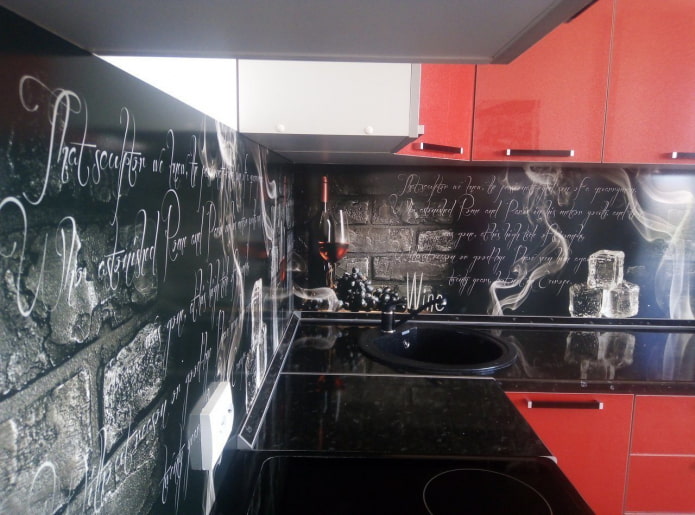
 10 practical tips for arranging a small kitchen in the country
10 practical tips for arranging a small kitchen in the country
 12 simple ideas for a small garden that will make it visually spacious
12 simple ideas for a small garden that will make it visually spacious
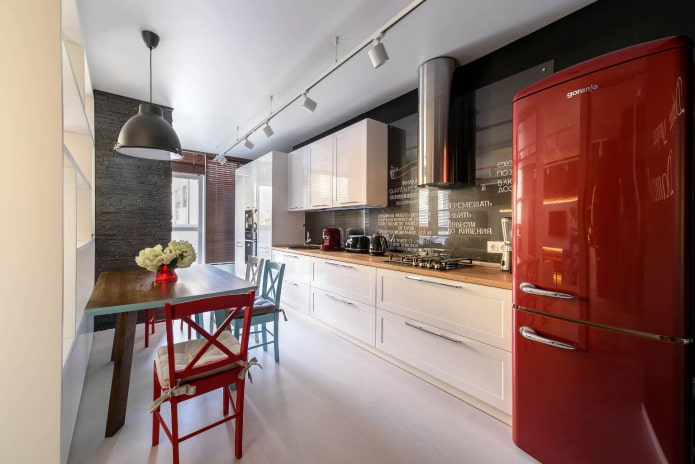
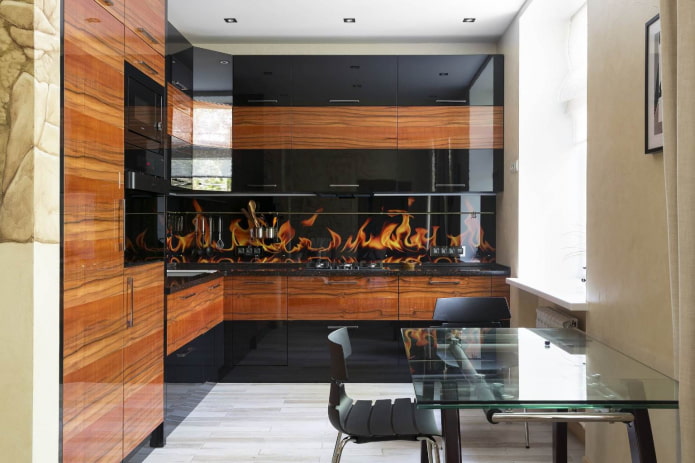
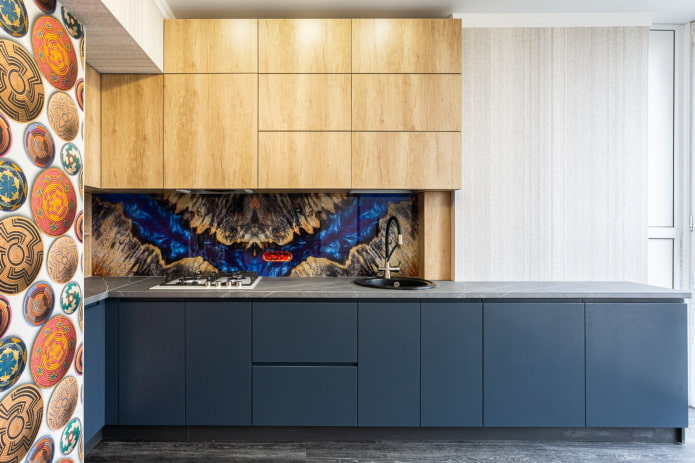
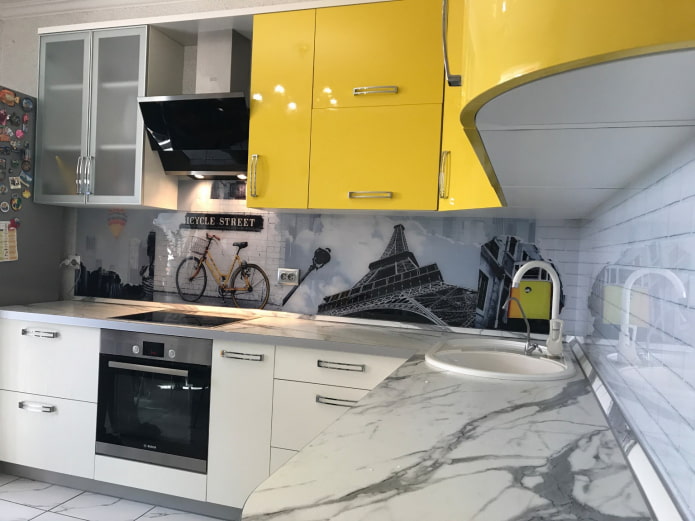
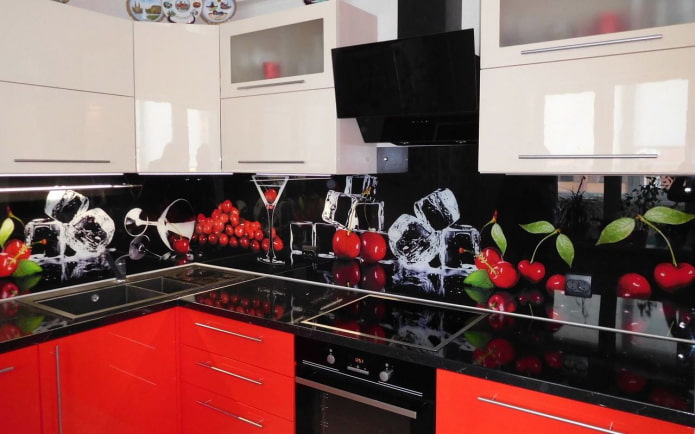
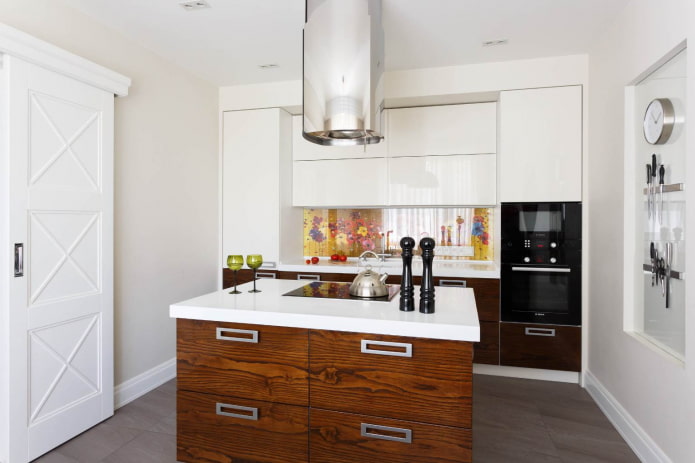
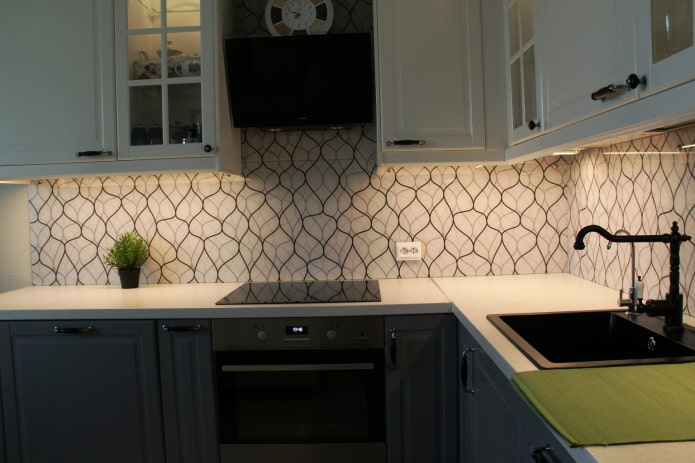
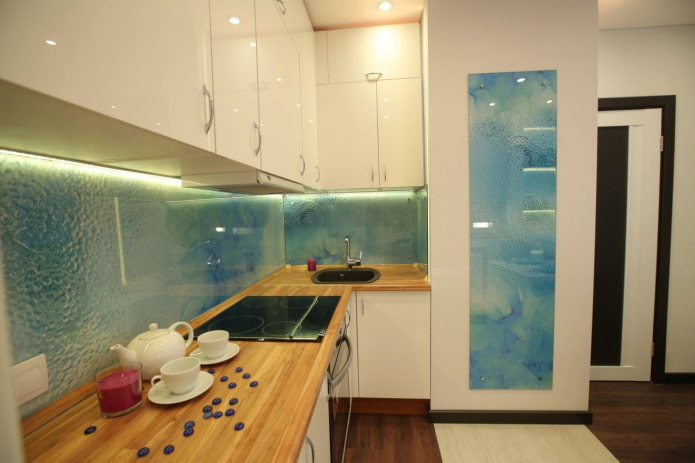
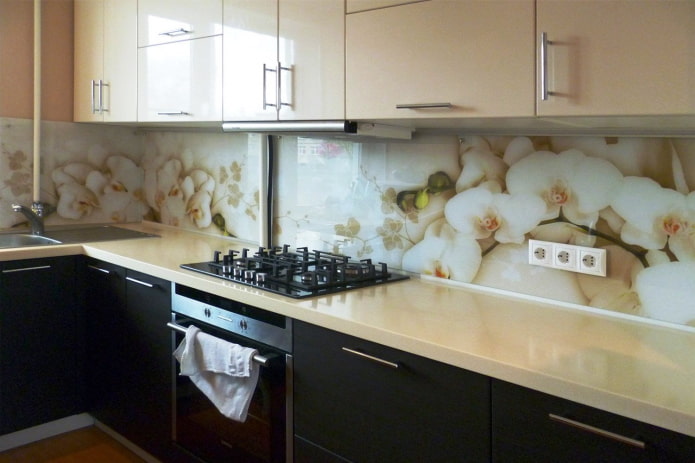
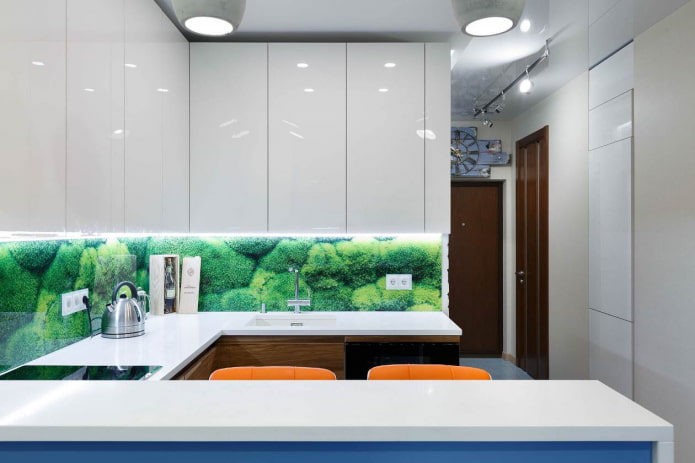
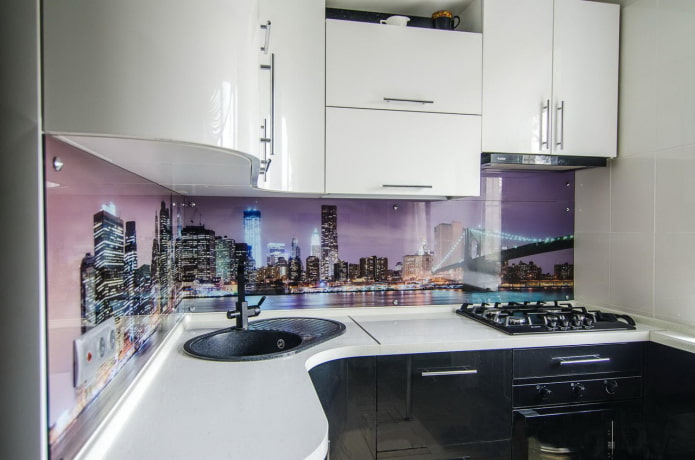
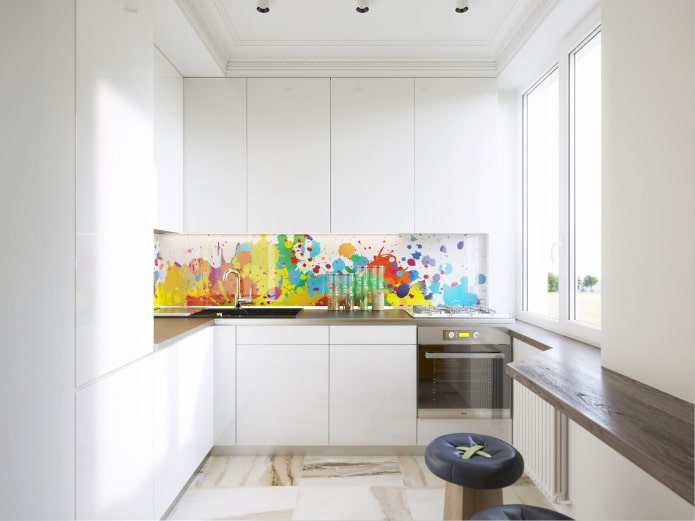

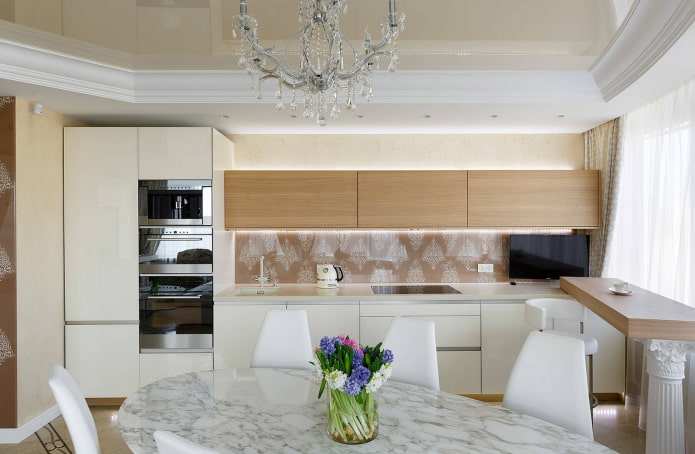
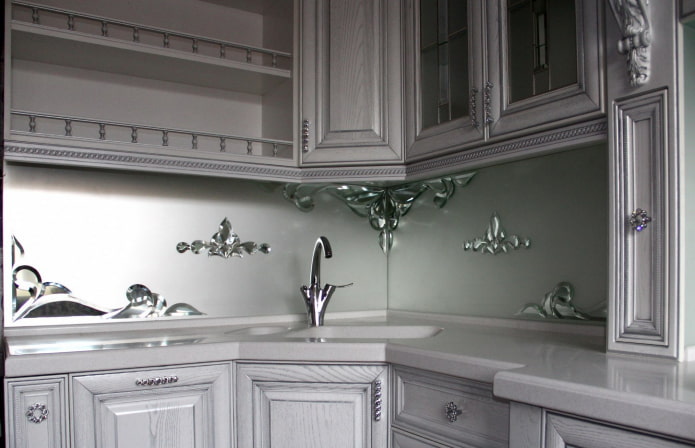
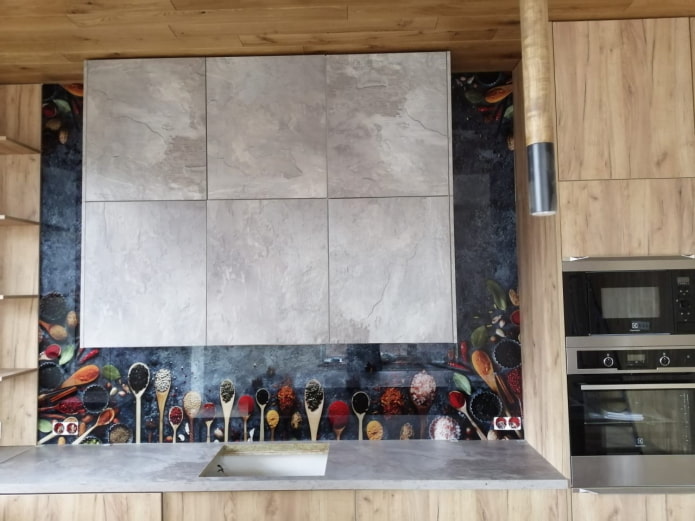
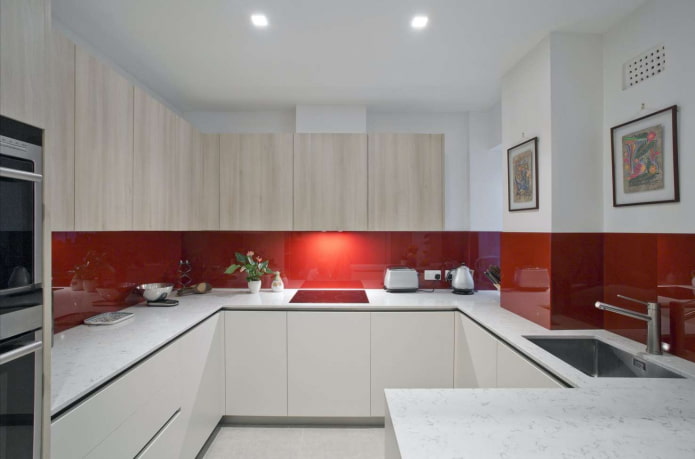
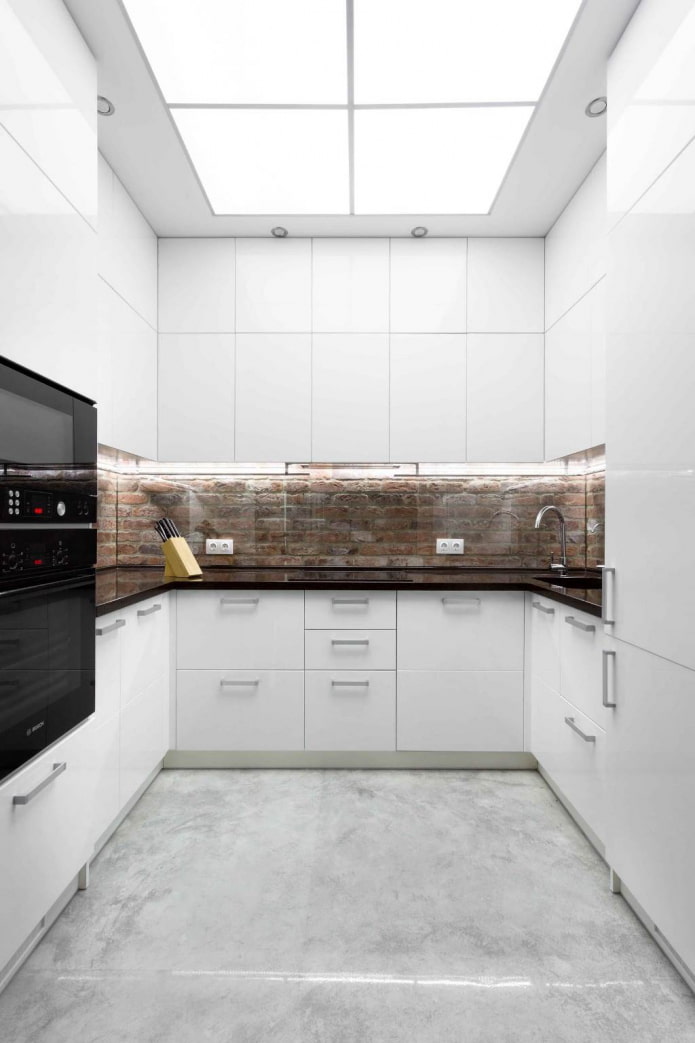
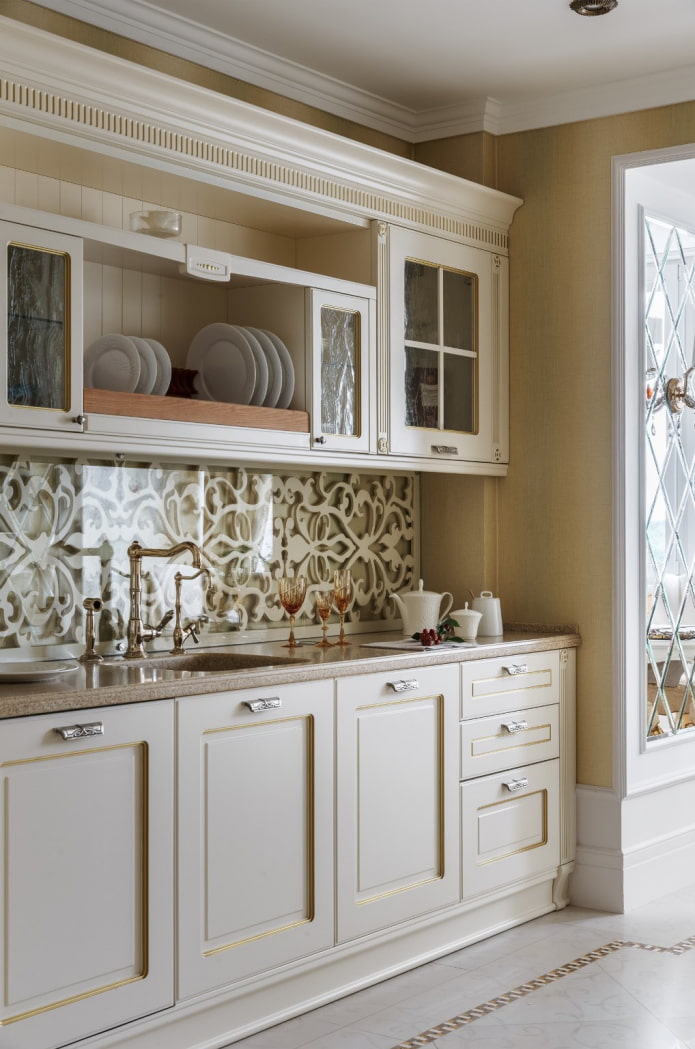
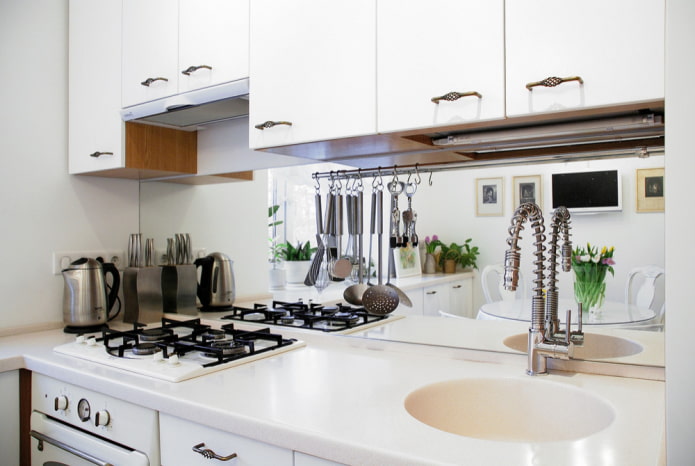
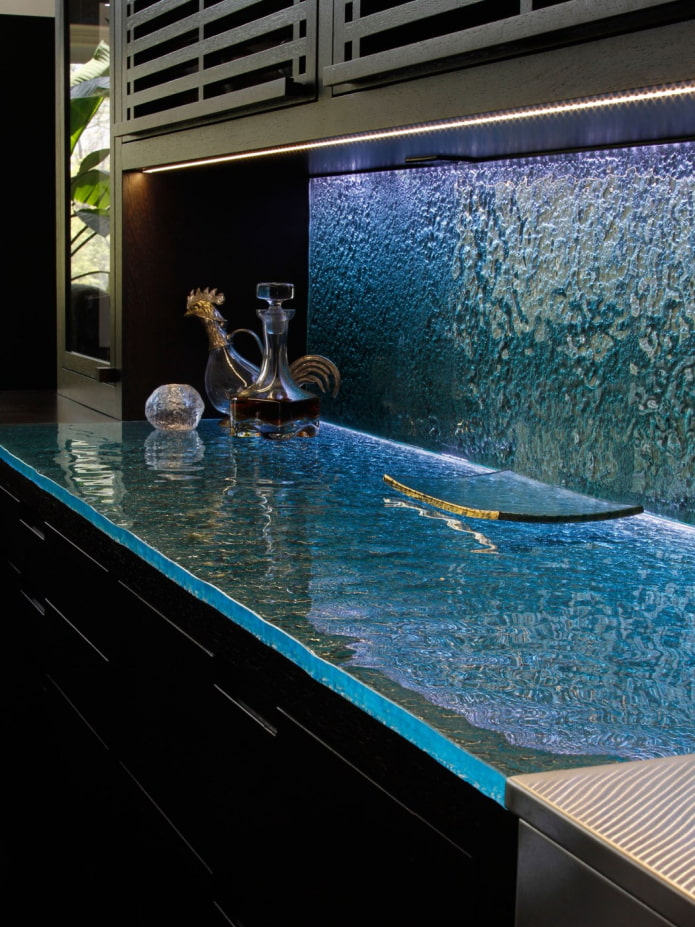
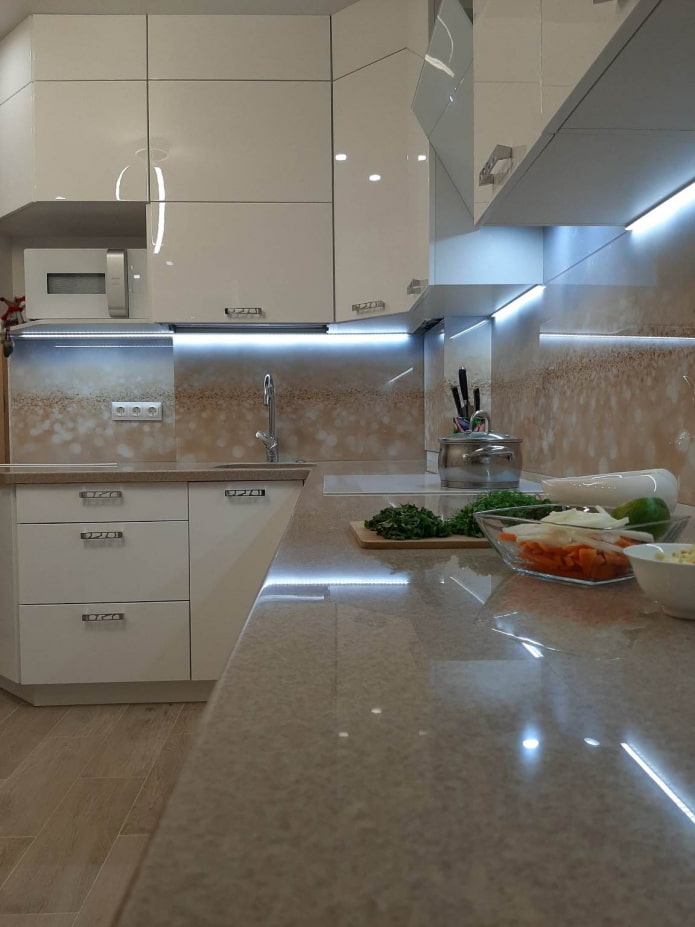
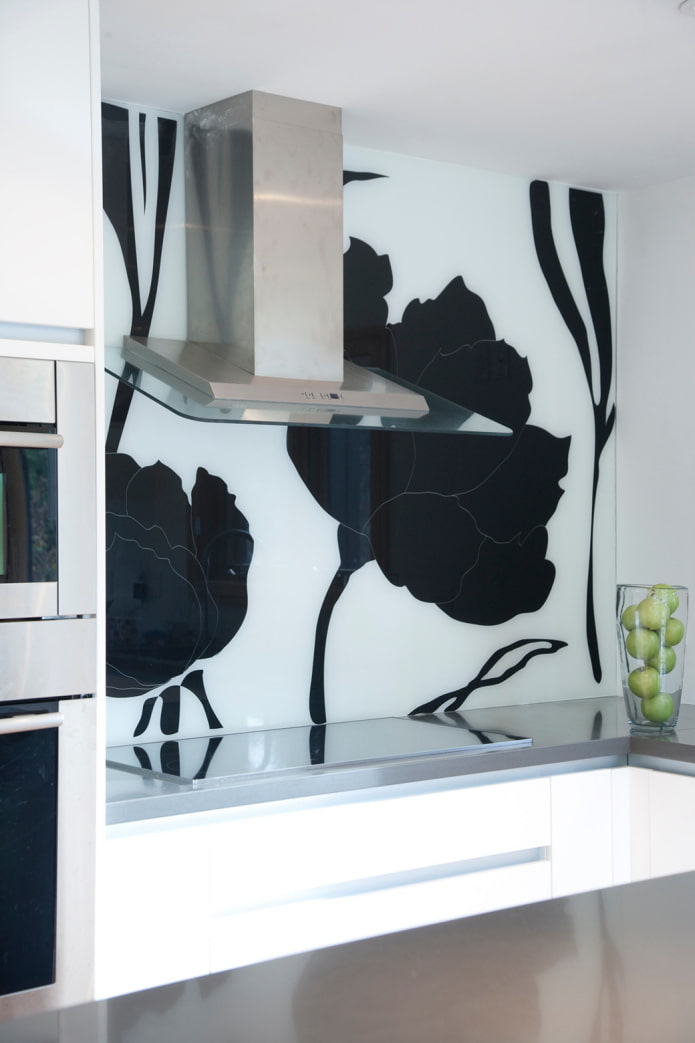
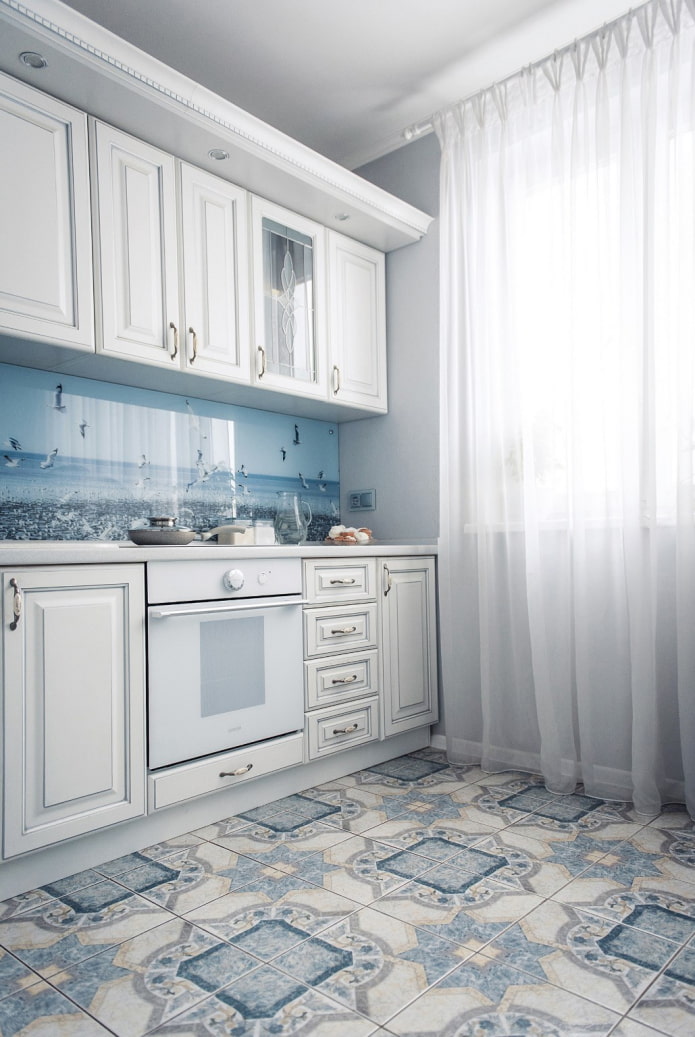
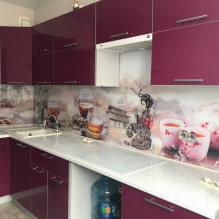
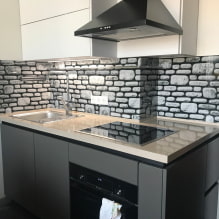
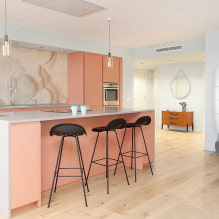
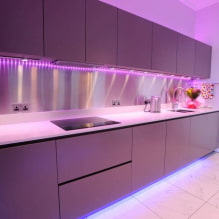
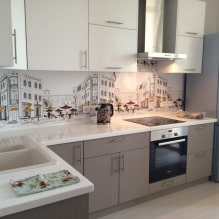
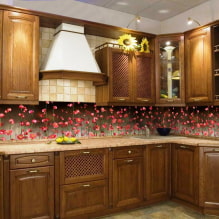
 How to choose the color of your kitchen sink?
How to choose the color of your kitchen sink? White kitchen set: features of choice, combination, 70 photos in the interior
White kitchen set: features of choice, combination, 70 photos in the interior Black set in the interior in the kitchen: design, choice of wallpaper, 90 photos
Black set in the interior in the kitchen: design, choice of wallpaper, 90 photos How to choose curtains for the kitchen and not regret it? - we understand all the nuances
How to choose curtains for the kitchen and not regret it? - we understand all the nuances Design of a white kitchen with a black countertop: 80 best ideas, photos in the interior
Design of a white kitchen with a black countertop: 80 best ideas, photos in the interior Kitchen design with green wallpaper: 55 modern photos in the interior
Kitchen design with green wallpaper: 55 modern photos in the interior